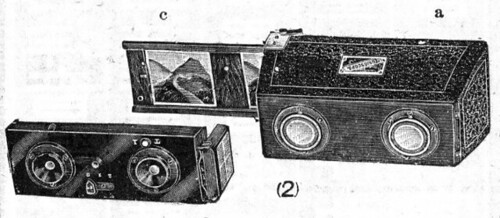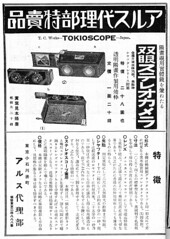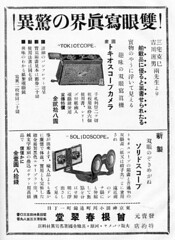Tokioscope
The Tokioscope (トキオスコープ) is a Japanese stereo camera taking glass plates, made by Tokyo Camera Works, the manufacturing branch of Sone Shunsuidō in the 1920s.
Description
The Tokioscope was a copy of one version of the Richard Glyphoscope, called "Glyphoscope (type 3)" in McKeown.[1] It has a rigid leather-covered wooden body, slightly tapered towards the front. The dimensions are 83×60×135mm.[2] The viewfinder is at the left end, as seen by the photographer; its front part has a large optical element and is hinged to the front plate, and its rear part consists of a small round eyepiece pivoting along the rear edge of the body. The name TOKIOSCOPE appears on a nameplate attached above the main body.
The camera takes pairs of 37×50mm exposures on standard 45×107mm plates or on 42×108mm plates, obtained by cutting tefuda-size plates in two.[3]

|
| Front plate, main body and transparency holder. (Image rights) |
The front plate contains the shutter and aperture mechanism, whereas the lenses are attached to the main body itself. The lenses are fixed-focus meniscus achromat of about f/11 aperture, allowing pictures from 6ft to infinity.[4] They are said to have 60mm focal length.[5] The whole front plate can be removed, and the main body is then used as a stereo viewer, with a transparency holder in the back instead of the plate holder.
The guillotine shutter is wound by a sliding lever between the two lenses, and another small lever switches from Time to Instant (advertised as about 1/50).[6] The Waterhouse stops are controlled by a three-position sliding lever with click-stops and 0, 1, 2 indications, said to correspond to f/8, f/16 and f/22.[7] The settings are written upside down on the front plate, so that the photographer can read them after having swiveled the camera along its longitudinal axis.[8] The setting levers are black painted on some examples and are silver finished on others.[9]
Commercial life

|

|
| Advertisements in Ars Camera June 1926 by Sone Shunsuidō (left) and Ars (right). (Image rights) | |
The Tokioscope was advertised in the June 1926 issue of Ars Camera by Sone Shunsuidō and by Ars, the publisher of the magazine which also acted as a camera distributor on occasions. The advertisement by Sone mentions the special price of ¥28, limited to 1,000 units, including six holders for half-tefuda plates. The following accessories are offered too:
- contact exposure frame, to produce transparencies, ¥1.20;
- dry plates, one dozen, ¥0.60;
- plate holder, ¥1.20;
- case, ¥4;
- processing tank, ¥5.
Sample pictures were offered for ¥0.20, and the user manual cost ¥0.07.
The June 1926 advertisement by Ars blatantly says that the camera is patterned after the French Glyphoscope. It gives the same price of ¥28, including six single-sided plate holders, one transparency holder and a cable release. The contact exposure frame for transparencies is listed separately, for ¥1.20.

|

|

|
| Advertisements by Sone Shunsuidō in Ars Camera December 1926 (left) and May 1927 (middle), and in Asahi Camera March 1928 (right). (Image rights) | ||
The advertisements by Sone in the December 1926 and May 1927 issues of Ars Camera present the Tokioscope together with a Solidoscope (ソリドスコープ) adjustable focusing stereo viewer (¥1.80), said to accept both the pictures produced by the Tokioscope and the pictures in standard stereo format. The Tokioscope is presented by Miyake Kokki (三宅克巳), a Japanese painter, and Yoshikawa Hayao (吉川速男), who wrote various books on photography.
The Tokioscope also appears in an advertisement by Sone in the March 1928 issue of Asahi Camera, again for ¥28, along with the Solidoscope stereo viewer (¥1.80), the Adjuscope (アヂャスコープ) stereo viewer with adjustable eye spacing (¥3.50), and the Stereo Drawer (ステレオヅローワー) sliding tripod head for stereo pictures (¥3).
Notes
- ↑ McKeown, p.821.
- ↑ Naohara, p.415 of Shashin Kōgyō no.66.
- ↑ 37×50mm exposures: Sugiyama, item 6003. The advertisement by Ars in Ars Camera June 1926 mentions "4.5×10.5cm" plates (actually 45×107mm) and half-tefuda plates. The advertisement by Sone in the same issue of the magazine only mentions half-tefuda.
- ↑ Meniscus achromat, about f/11, sharp from 6ft to infinity: advertisement by Ars in Ars Camera June 1926.
- ↑ Naohara, p.415 of Shashin Kōgyō no.66.
- ↑ 1/50: advertisement by Ars in Ars Camera June 1926. Naohara, p.415 of Shashin Kōgyō no.66, says 1/25, perhaps closer to the truth.
- ↑ Click-stops, f/8, f/16, f/22: Naohara, p.415 of Shashin Kōgyō no.66.
- ↑ The example pictured in Sugiyama, item 6003, is placed upside down.
- ↑ Black levers: example pictured in Shima, p.25 of Kurashikku Kamera Senka no.27. Silver levers: example pictured in Sugiyama, item 6003.
Bibliography
- Ars Camera. Advertisements by Sone Shunsuidō in June and December 1926 and advertisement by Ars in June 1926. No page numbers.
- Asahi Camera. Advertisement by Sone Shunsuidō in March 1928 (p.A18).
- Lewis, Gordon, ed. The History of the Japanese Camera. Rochester, N.Y.: George Eastman House, International Museum of Photography & Film, 1991. ISBN 0-935398-17-1 (paper), 0-935398-16-3 (hard). P.28.
- McKeown, James M. and Joan C. McKeown's Price Guide to Antique and Classic Cameras, 12th Edition, 2005-2006. USA, Centennial Photo Service, 2004. ISBN 0-931838-40-1 (hardcover). ISBN 0-931838-41-X (softcover). P.821 (on the Glyphoscope).
- Naohara J. (直原寂田). "Omoide no Tokiosukōpu" (思い出のトキオスコープ, "Memoirs of Tokioscope Camera"). In Shashin Kōgyō no.66 (October 1957). Pp.413–5. (This is a testimony from a reader of the magazine who was using the Tokioscope from the 1920s.)
- Shima Kazuya (島和也). "Sutereo kamera onparēdo" (ステレオカメラオンパレード, Stereo cameras on parade). Kamera Rebyū: Kurashikku Kamera Senka (カメラレビュー クラシックカメラ専科) / Camera Review: All about Historical Cameras no.27, December 1993. No ISBN number. Stereo World (ステレオワールド). Pp.21–5.
- Sugiyama, Kōichi (杉山浩一); Naoi, Hiroaki (直井浩明); Bullock, John R. The Collector's Guide to Japanese Cameras. 国産カメラ図鑑 (Kokusan kamera zukan). Tokyo: Asahi Sonorama, 1985. ISBN 4-257-03187-5. Item 6003.
